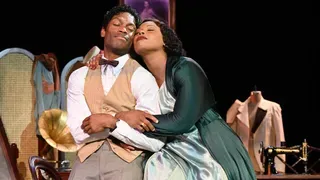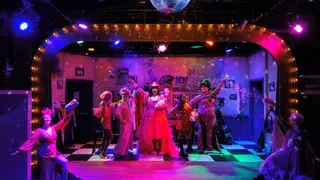June 28, 2005
Elaine Stritch: At Liberty (Ptown)
Robert Nesti READ TIME: 4 MIN.
?So what has this all been about then, this existential problem in tights?? asks Elaine Stritch towards the end of ?Elaine Stritch at Liberty? at the Wilbur Theatre. Up to that point she?s taken the audience on a journey from the sunken living room of her childhood home in the suburbs of Detroit (where she had her first taste of liquor) to New York, Los Angeles, and London, and an acting career that brought her contact with some of the 20th century?s greatest talents. But, she wonders, just what was it all about?
It?s a piercing question that frames this compelling solo stint that at 3-hours would tax a performer half Stritch?s age. But at 79 she?s still game to push herself, as when she breathlessly darts across the stage between verses of the song ?Zip,? recreating her daily trip from Broadway?s Imperial Theatre, where she was understudying Ethel Merman in ?Call Me Madam? to New Haven?s Shubert Theatre, where she sang that number in a revival of ?Pal Joey.? Or treat audiences to the original choreography of a very un-PC song (?Civilization?) from a long-forgotten revue that marked her Broadway debut. With the help of John Lahr, Stritch stitches together these kinds of anecdotes and songs into a brilliant collage of an actress at war with herself.
Taming her demons, in this case alcohol, becomes her focus; but don?t go expecting some neat, empowering homily on addiction. Stritch?s way of finding inner peace is as unique as the lady herself. If there were 12-steps, she keeps them to herself. Instead treats the audience to her no-nonsense account of her life, interspersed with songs that she either introduced in shows ( ?Why Do the Wrong People Travel?,? ?The Ladies Who Lunch?) or fit the rueful moment of her narrative (?If Love Were All,? ?The Party?s Over.?)
She arrives on stage tentatively, dressed in just a white shirt and black tights that seem to underscore her vulnerability. What you notice first are her legs, long and lean. (They bring to mind the famous quote by Spencer Tracy about Katherine Hepburn: ?Not much meat on her, but what's there is cherce.?) Within seconds, though, she commands the stage with a set of one-liners and a soft shoe routine (to the tune of ?There?s No Business like Show Business?) that sets the tone for what?s to follow. From this point on Stritch is a bit like a salty Sheheherzade, dispensing stories in a hypnotic fashion. Her account of a horrible date with Marlon Brando has a piercing intensity ? was she that na?ve not to sense his wolfish arrogance? Her failed romances with Gig Young, Ben Gazzara, and Rock Hudson show her as unlucky in love; and her success with Noel Coward, who wrote a musical (?Sail Away?) especially for her, prove that she could do something right, at least professionally.
As interesting as these stories are, it?s not until the second half does Stritch find her stride, and delve into the complex problems that alcohol brought to her career. She may have triumphed in ?Company,? but only after she nearly blew it by forgetting a lyric in the first performance in Boston. Towards the end she tells an anecdote of how she had a bit too much brandy during a performance of that show, and was gently admonished by the show?s co-producer Ruth Mitchell with the advice: ?Extraordinary talent, Elaine. Don?t fuck it up.?
But the point of ?Elaine Stritch at Liberty? is that she nearly did fuck it up, despite triumphs in London in the 1970?s when her career and personal life were finally in perfect synch. Prior to that she tells a hilarious story of one of her low points, a touring production of ?The Women? with Gloria Swanson and Marge Champion where her smart-ass behavior led her to be expulsed from the cast; and another of how she tricked a producer into believing she was not drinking by sneaking a doctored champagne bottle backstage. If anything, she was willful. A diabetes diagnosis and a hyperglycemic reaction lead her to stop drinking, and with it the sad realization that she nearly missed it all. ?Absent always,? she says quoting Beckett (of all people.) ?Okay. I?ll paraphrase. Absent almost always. Oh, my goodness. It almost all happened without me.?
Stritch still sings in a gravely alto belt that?s been her signature since the 1950?s; it may have deepened some, but it still has surprising color and range. She also has the kind of expressive face that reaches to the far reaches of the hall. She is, as she points out, one of the few performers who can sing ?I?m Still Here? and make sense of the lyric. When she does, she induces Goosebumps.
The show may be all Stritch; but she gets superb assistance from director George C. Wolfe, who knows that physical placement and lighting is as important as delivery: Stritch, alone on the stage with just a chair, always seem to be in the right place at the right time in just the right hue of Jules Fisher and Peggy Eisenhauer?s beautifully tuned lighting design. She is accompanied from a terrific band under the assured direction of Rob Bowman with transparent orchestrations by Jonathan Tunick. It takes a collaboration of such high professionalism to allow this performer to be so exposed with such passion and humility.
Robert Nesti can be reached at [email protected].






